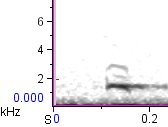Pygmy-Owl vs. Chipmunk
In addition to the comments on my recent pygmy-owl post, I got five private emails, all of which also implicated Merriam’s Chipmunk as the likely source of the pygmy-owl-like sound. I emailed Doug Von Gausig, and he was very amenable to the possibility that he might have recorded a chipmunk instead of a pygmy-owl. I think this is likely the case.
The best evidence came from a 1976 paper by Leonard Brand in the journal Animal Behaviour: “The vocal repertoire of chipmunks (Genus Eutamias) in California” (email me for a PDF copy). In addition to the “chip” calls that are the most common form of alarm note in all ten chipmunk species in California, Brand mentions a “chuck” call that matches our mystery sound:
Chucks were lower pitched than chips, with their fundamental frequency between 0.5 and 2.0 kHz. Their lowest frequencies were at the beginning and end, with higher frequencies in the middle of the syllable. Eutamias townsendii chucks had from zero to five harmonics at approximately 2 kHz intervals. Each chuck was from 0.03 to 0.05 sec long. Chucks were given by all species, and they all had a form similar to E. townsendii [emphasis mine]. Chucks were usually given…in a steady series, from 50 to 178 per min.
The description is a pretty good match for the pygmy-owl-like sound, but I think the real clincher is Brand’s spectrogram of the “chuck” call:
 |  |
|---|---|
| "Chuck" call of Townsend's Chipmunk (Tamias townsendii), adapted from Brand (1976), Fig. 5. | Probable "chuck" call of Merriam's Chipmunk (T. merriami, Chews Ridge, Monterey County, CA, 1/12/2009. Recording by Andrew Spencer. |
I fiddled with the axes on the spectrogram of Andrew’s recording to make the two as comparable as possible, and although there are slight differences, the similarities are striking, right down to the faint third voice in between the fundamental and the first harmonic.
Brand was using a Kay Electric Company spectrograph machine on the wide-band setting, which explains the much thicker lines on his spectrogram. Although I’m not a fan of the wide-band setting, I do have to applaud Brand for resisting the temptation to trace his spectrograms, as was the rage in the 1970s. Thank goodness we have computers to do the dirty work for us these days!
Overall, I see no reason not to identify Andrew’s recording as the “chuck” call of a chipmunk, which would make it a Merriam’s Chipmunk (Tamias merriami), the only species in Monterey County. Here’s another link to the sound:
I still marvel at the uncanny resemblance to an owl!